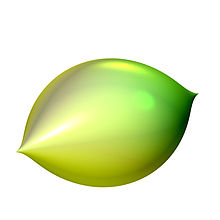
The Fields Medal is a prize awarded to two, three, or four mathematicians under 40 years of age at the International Congress of the International Mathematical Union (IMU), a meeting that takes place every four years. The name of the award honours the Canadian mathematician John Charles Fields.

In geometry, Boy's surface is an immersion of the real projective plane in 3-dimensional space found by Werner Boy in 1901. He discovered it on assignment from David Hilbert to prove that the projective plane could not be immersed in 3-space.

The Foucault pendulum or Foucault's pendulum is a simple device named after French physicist Léon Foucault, conceived as an experiment to demonstrate the Earth's rotation. A long and heavy pendulum suspended from the high roof above a circular area was monitored over an extended time period, showing that its plane of oscillation rotated.

The Oberwolfach Research Institute for Mathematics is a center for mathematical research in Oberwolfach, Germany. It was founded by mathematician Wilhelm Süss in 1944.
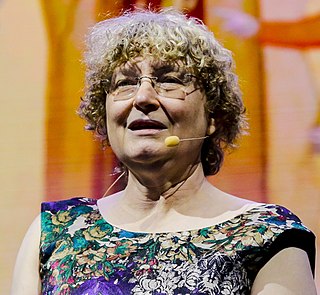
Baroness Ingrid Daubechies is a Belgian physicist and mathematician. She is best known for her work with wavelets in image compression.

Lothar Collatz was a German mathematician, born in Arnsberg, Westphalia.
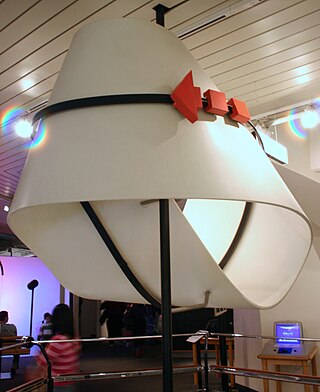
Mathematica: A World of Numbers... and Beyond is a kinetic and static exhibition of mathematical concepts designed by Charles and Ray Eames, originally debuted at the California Museum of Science and Industry in 1961. Duplicates have since been made, and they have been moved to other institutions.

Mykhailo Zakharovych Zghurovskyi, also spelled as Mykhailo Zgurovsky,, Minister of Education and Science of Ukraine. Today he is a rector of the Igor Sikorsky Kyiv Polytechnic Institute.
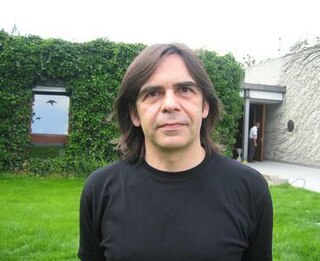
Endre Süli is a mathematician. He is Professor of Numerical Analysis in the Mathematical Institute, University of Oxford, Fellow and Tutor in Mathematics at Worcester College, Oxford and Adjunct Fellow of Linacre College, Oxford. He was educated at the University of Belgrade and, as a British Council Visiting Student, at the University of Reading and St Catherine's College, Oxford. His research is concerned with the mathematical analysis of numerical algorithms for nonlinear partial differential equations.
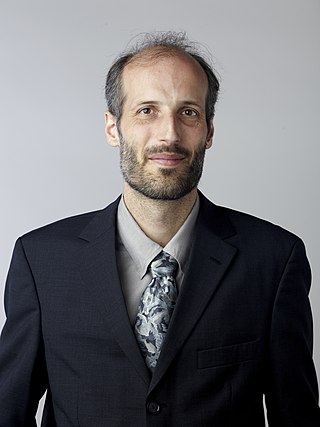
Sir Martin Hairer is an Austrian-British mathematician working in the field of stochastic analysis, in particular stochastic partial differential equations. He is Professor of Mathematics at EPFL and at Imperial College London. He previously held appointments at the University of Warwick and the Courant Institute of New York University. In 2014 he was awarded the Fields Medal, one of the highest honours a mathematician can achieve. In 2020 he won the 2021 Breakthrough Prize in Mathematics.
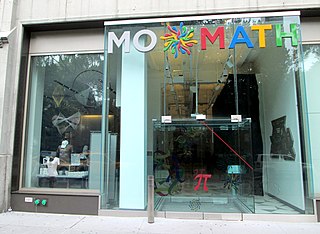
The National Museum of Mathematics or MoMath is a museum in Manhattan, New York City dedicated to mathematics. Opened on December 15, 2012, it was the first museum in the United States dedicated to mathematics, and features over thirty interactive exhibits. The mission of the museum is to "enhance public understanding and perception of mathematics". The museum is known for a special tricycle with square wheels, which operates smoothly on a catenary surface.

Frank Natterer is a German mathematician. He was born in Wangen im Allgäu, Germany. Natterer pioneered and shaped the field of mathematical methods in imaging including computed tomography (CT), magnetic resonance imaging (MRI) and ultrasonic imaging.

Rouben V. Ambartzumian is an Armenian mathematician and Academician of National Academy of Sciences of Armenia. He works in Stochastic Geometry and Integral Geometry where he created a new branch, combinatorial integral geometry. The subject of combinatorial integral geometry received support from mathematicians K. Krickeberg and D. G. Kendall at the 1976 Sevan Symposium (Armenia) which was sponsored by Royal Society of London and The London Mathematical Society. In the framework of the later theory he solved a number of classical problems in particular the solution to the Buffon Sylvester problem as well as the Hilbert's fourth problem in 1976. He is a holder of the Rollo Davidson Prize of Cambridge University of 1982. Rouben's interest in Integral Geometry was inherited from his father. Nobel prize winner Allan McLeod Cormack Laureate for Tomography wrote: "Ambartsumian gave the first numerical inversion of the Radon transform and it gives the lie to the often made statement that computed tomography would have been impossible without computers". Victor Hambardzumyan, in his book "A Life in Astrophysics", wrote about the work of Rouben V. Ambartzumian, "More recently, it came to my knowledge that the invariance principle or invariant embedding was applied in a purely mathematical field of integral geometry where it gave birth to a novel, combinatorial branch." See R. V. Ambartzumian, «Combinatorial Integral Geometry», John Wiley, 1982.

Sara Anna van de Geer is a Dutch statistician who is a professor in the department of mathematics at ETH Zurich. She is the daughter of psychologist John P. van de Geer.

KaTeX is a cross-browser JavaScript library that displays mathematical notation in web browsers. It puts special emphasis on being fast and easy to use.
Gabriele Vezzosi is an Italian mathematician, born in Florence (Italy). His main interest is algebraic geometry.
Claude Dellacherie is a French mathematician, specializing in probability theory.
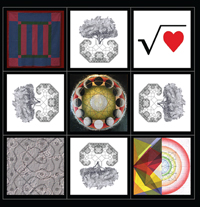
Rhythm of Structure is a multimedia interdisciplinary project founded in 2003. It features a series of exhibitions, performances, and academic projects that explore the interconnecting structures and process of mathematics and art, and language, as way to advance a movement of mathematical expression across the arts, across creative collaborative communities celebrating the rhythm and patterns of both ideas of the mind and the physical reality of nature.

Yongjie Jessica Zhang is an American mechanical engineer. She is the George Tallman Ladd and Florence Barrett Ladd Professor of mechanical engineering and, by courtesy, of biomedical engineering at Carnegie Mellon University. She is the Editor-in-Chief of Engineering with Computers.
Leonid Isakovich Manevitch was a Soviet and Russian physicist, mechanical engineer, and mathematician. He made fundamental contributions to areas of nonlinear dynamics, composite and polymer physics, and asymptotology.
